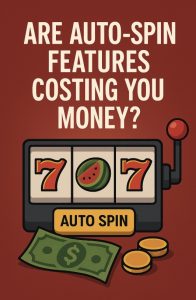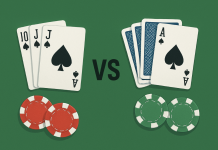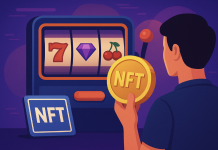Are Auto-Spin Features Costing You Money?
When it comes to real money online slots, few features are more divisive than the auto-spin button. For some players, it’s a convenience tool that helps maintain consistency and focus. For others, it’s a fast track to a drained bankroll. But what’s the truth? Are auto-spin features actually costing you money, or can they help you stay disciplined? The answer, as with most things in gambling, isn’t black and white.
Let’s explore how auto-spin works, how it impacts your play, and whether or not it’s helping or hurting your winning chances.
What Is Auto-Spin and How Does it Work?
Auto-spin (sometimes called “auto-play”) is a feature built into most modern-day online slot machines. It allows players to pre-set a number of automatic spins (usually anywhere from 10 to 100 or more) without having to click the spin button each time. Many versions of auto-spin also allow you to set specific conditions to stop, such as reaching a win or loss limit, triggering a bonus round, or finishing a set number of spins.
The feature is particularly popular among players who enjoy a hands-free experience or want to play while multitasking. But convenience comes at a cost, and it’s not always in the way you’d expect.
Auto-Spin and Speed: The Silent Bankroll Killer
One of the most significant issues with auto-spin is that it increases the pace of play. Slots are already fast, but when you remove the pause between each decision, you’re spinning at lightning speed—sometimes as quickly as one spin every two seconds!
The faster you spin, the more bets you make per minute. And the more bets you make, the quicker the house edge does its work. Over time, even a small edge becomes significant when applied to hundreds of spins in a short session.
Mindless Play Leads to Mindless Losses

Another concern is how auto-spin affects player behaviour. The convenience of auto-play can lead to disengagement, where the player zones out and becomes less aware of how much they’ve lost or how long they’ve been playing.
Without the natural pauses between spins to reassess or emotionally check in, players can fall into a sort of “gambling autopilot.” This disconnect increases the likelihood of chasing losses or ignoring win/loss boundaries. Even responsible gamblers may find themselves overspending without realising it and only notice the damage when their session ends or the balance hits zero.
Casinos and slot developers understand this psychology. The less friction there is between spins, the easier it is to keep players immersed and spending. Auto-spin is a tool that, while helpful, also encourages longer sessions and faster losses by design.
Auto-Spin as a Discipline Tool
While it’s easy to frame auto-spin as a trap, it’s worth noting that, for some players, it can be a powerful discipline tool, especially when used correctly.
Many online slots with auto-spin features now include stop-loss and stop-win settings. These allow you to walk away automatically once you’ve lost or won a predetermined amount. This can help remove emotion from decision-making and keep players from chasing losses or getting greedy during a lucky streak.
Used in conjunction with a solid bankroll management strategy, auto-spin can even help reduce the temptation to “just spin one more time.” For instance, setting a 50-spin limit and walking away once it finishes is often easier to stick to than manually deciding when to stop mid-session.
In this way, auto-spin becomes less about automation and more about structure. It can enforce limits where willpower may falter. This is especially for players who acknowledge their own impulse control challenges.
Why Auto-Play is Banned in Some Places
Some regulators are already taking a firm stance on auto-spin features. In the UK, for example, the Gambling Commission banned auto-play on all online slot games in 2021 as part of a broader move to make online gambling safer. The reasoning? Auto-play was linked to increased losses, longer play sessions, and a reduced sense of control.
This decision reflects growing concern that automation features in online gambling can mask problematic behaviour. Without the need to consciously press “spin” each time, players may find it harder to track spending or stop playing altogether. It also eliminates the opportunity for reflective pauses, which are important for responsible gambling practices.
While not all jurisdictions have followed suit, the UK’s decision signals a trend that could spread to other regions as more research emerges about the psychological effects of automation in gambling.
Tips for Using Auto-Spin Responsibly
If auto-spin is still available where you play and you choose to use it, consider the following tips to reduce risk:
- Always set a loss limit – Never run auto-play without a predefined stop-loss amount.
- Limit the number of spins – Avoid selecting the maximum number. Choose a realistic number you’re comfortable with.
- Take breaks between sets – Stop and reassess after every 20–50 spins to keep yourself aware.
- Don’t multitask – Auto-spin while distracted (e.g., watching TV or working) leads to unintentional overspending.
- Use time limits – Set a timer for your session and stick to it.
- Discipline is key – Auto-spin isn’t inherently dangerous—it’s how you use it that matters.
Conclusion: Autoplay is a Bit of a Double-Edged Sword
Auto-spin features aren’t necessarily evil, but they do carry risks. For players who value control, awareness, and discipline, auto-spin can offer a more structured experience. But for those prone to impulsive behaviour or emotional play, it can easily fast-track you to losses.
If you find your sessions are shorter, your losses are higher, or you’re regularly surprised by how quickly your balance disappears, it may be time to switch back to manual play. This trick with any risky gambling strategy or feature like auto-play is to know your tools and know your limits. Doing so will ensure you have a better chance at making your money and that your overall enjoyment lasts longer.




